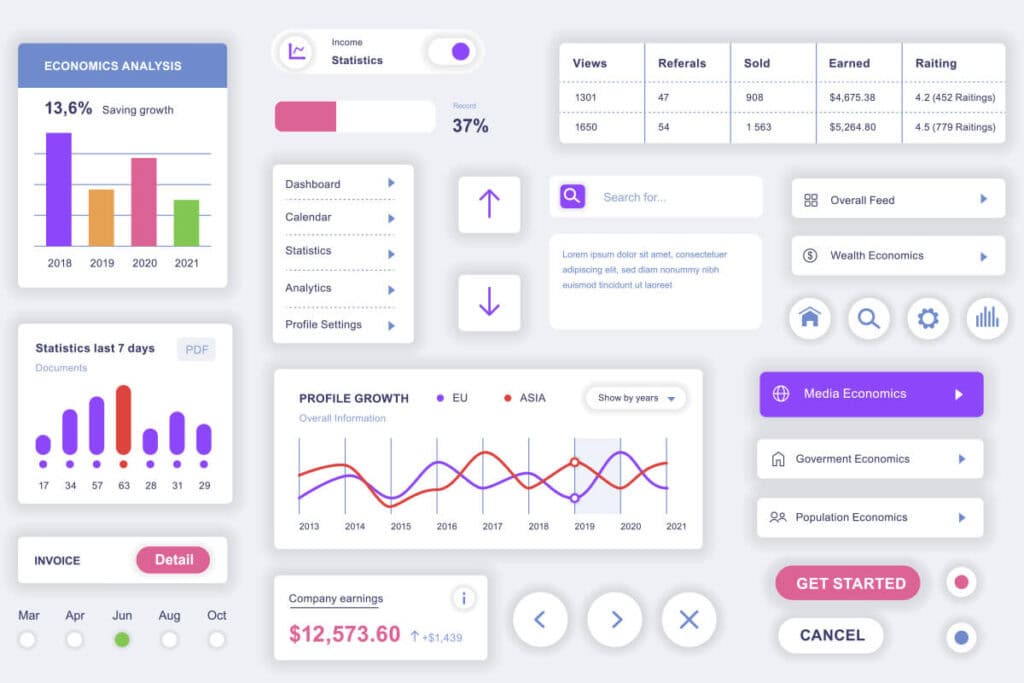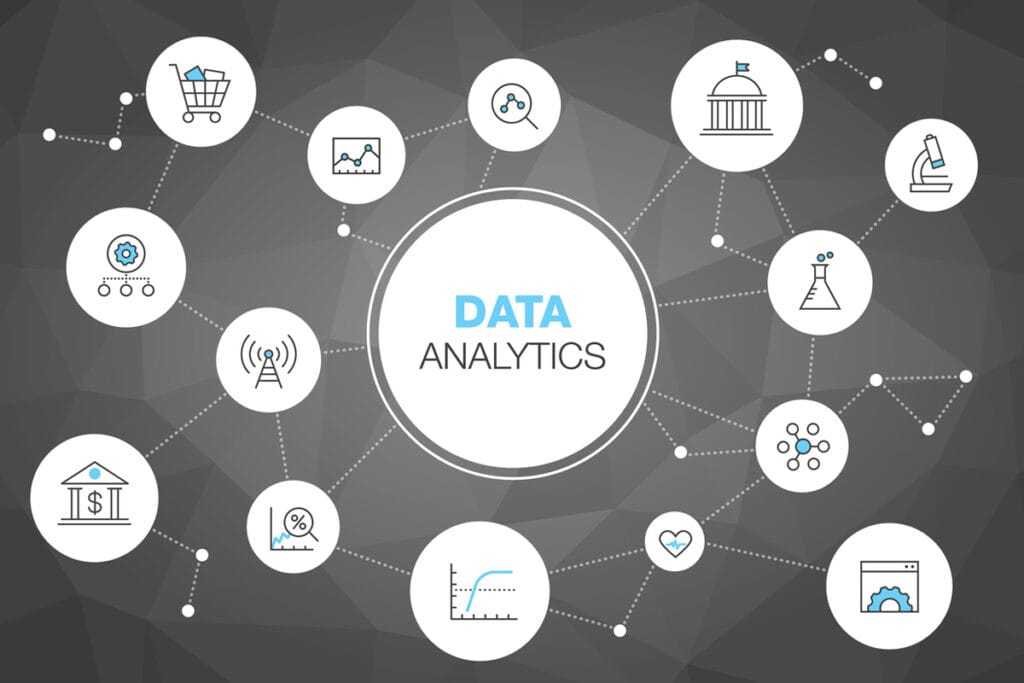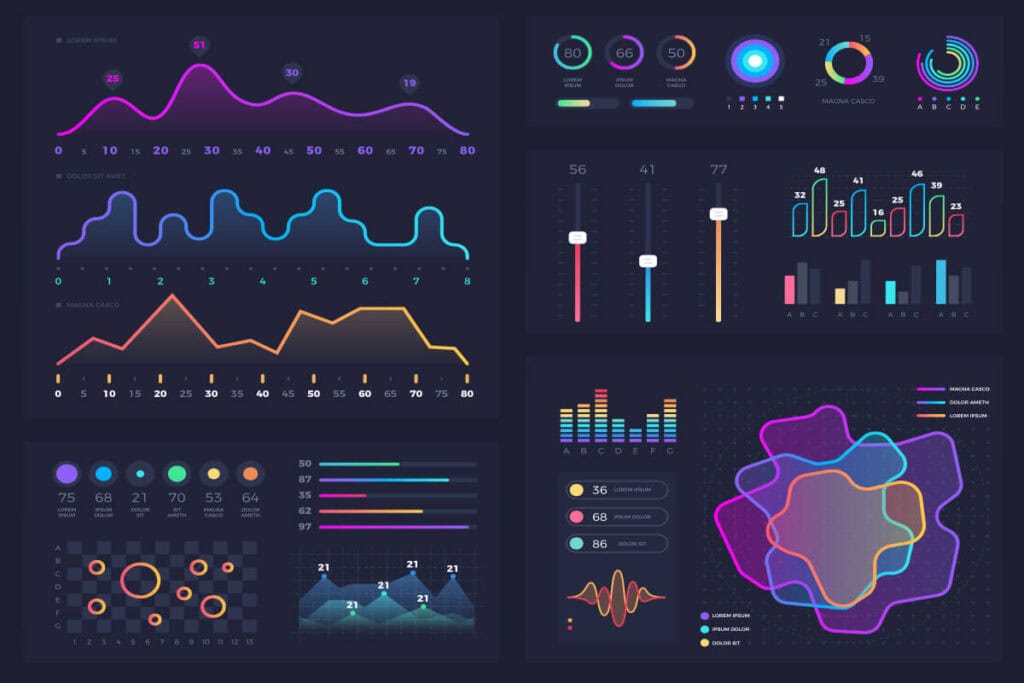Key Highlights
- Enterprise Business Intelligence (BI) enables businesses to make confident data-driven decisions
- Through data analysis, Enterprise BI helps businesses identify market trends, changes in customer behavior, and gain operational efficiency.
- The core components of Enterprise BI architecture include advanced data integration techniques, secure and scalable data storage solutions, comprehensive data analytics and reporting, and comprehensive data visualization tools.
- The convergence of BI and AI improves decision-making by automating data analysis, and easing predictive analytics and machine learning.
- Implementing Business Intelligence in an organization involves developing a successful BI strategy, monitoring key performance indicators (KPIs), building an effective BI team, and choosing the right BI tools and software.
- The challenges associated with Enterprise BI include addressing data collection and quality management and ensuring user adoption and training.
Table of Contents
Toggle
Introduction
With growing amounts of data being generated, businesses need an efficient way to collect, analyze, and interpret this data to gain insights and make important business decisions. This is where BI software plays an important role. Having worked with many reporting tools and business providers when I worked at Oracle and Actian I realized database providers could not do it all when it came to showcasing data. There is no substitute for real-time BI dashboards to show off what data management providers do best, which is deliver high quality data.
Enterprise BI involves collecting, storing, and analyzing data from daily operations to provide intelligent insights for business leaders so they can make better informed decisions. This helps businesses maintain their competitive advantage by anticipating market trends, better understanding customer behavior, and gaining greater operational efficiency.
The scope of Enterprise BI, covers all aspects of a business’s operations. From sales and marketing to finance and supply chain management, Enterprise BI provides valuable insights into every department. By analyzing data from sources such as customer data, market trends, and operational data, businesses can identify patterns, spot opportunities, and address challenges.

Defining Enterprise Business Intelligence and Its Scope
Enterprise Business Intelligence refers to the deployment of BI in large enterprises to analyze data and gain insights that can drive business decisions. It involves the use of technology and tools to collect, store, and analyze data to support data-driven decision making.
Enterprise BI solutions enable businesses to identify possible issues that need to be addressed for a faster and more informed decision-making process. These solutions provide a comprehensive view of the business, allowing leaders to make data-driven decisions. By analyzing data from various sources, such as customer data, market trends, and operational data, businesses can uncover insights that lead to increased productivity and efficiency in an enterprise, all through the use of BI dashboards. Through the use of its data assets, businesses can gain a competitive edge in the market and drive growth.

The Core Components of Enterprise BI Architecture
Enterprise BI architecture consists of several core components that work together to allow a business to collect, store, analyze, and visualize data. These components include advanced data integration technology, secure and scalable data storage solutions, comprehensive data analytics, reporting, and data visualization tools.
Advanced data integration techniques involve combining data from various sources, such as data warehouses and data lakes, to create a unified view of the business. Secure and scalable data storage solutions, including data marts, ensure that data is stored safely and can be accessed and analyzed efficiently. Comprehensive data analytics and reporting software allow businesses to derive insights and make more data-driven decisions. Data visualization tools enable businesses to present data in a visually appealing and understandable format, making it easier to interpret and act upon it.

Advanced Data Integration Techniques
Data integration is a crucial component of Enterprise BI architecture that involves combining data from various sources into a unified view. It ensures that businesses have access to accurate and up-to-date information for analysis and decision-making. A common data integration is to populate data warehouses. A data warehouse is a central repository that stores structured data from different sources and provides a unified view of the data allowing businesses to run complex queries and analysis on large volumes of data.
Data integration technology also helps to populate and extract data from data lakes. A data lake is a storage repository that holds a vast amount of raw and unprocessed data. Storing data in its original format provides flexibility for future analysis projects.
Secure and Scalable Data Storage Solutions
In enterprise business intelligence (EBI), secure and scalable data storage solutions are critical for managing and accessing data efficiently. One such solution is Amazon Web Services (AWS), a cloud computing platform that offers a wide range of storage options. AWS provides businesses with reliable and secure data storage solutions, including Amazon S3 (Simple Storage Service) and Amazon RDS (Relational Database Service). These services offer high durability, availability, and scalability, ensuring that businesses can store and access their data without disruptions.
Data management is also an essential aspect of secure and scalable data storage. AWS provides various data management services, such as Amazon Redshift for data warehousing, Amazon Aurora for high-performance databases, and Amazon Glacier for long-term data archiving. Amazon also hosts third-party data storage solutions from providers such as Actian and Snowflake.

Comprehensive Data Analytics and Reporting
Comprehensive data analytics and reporting capabilities are vital in enterprise business intelligence. Data analytics helps to uncover patterns, trends, and insights. Business intelligence tools provide the necessary capabilities to perform data analysis and generate reports.
With data analytics, businesses can gain valuable insights from their data, identify patterns and trends, and make informed decisions. By analyzing historical and real-time data, businesses can understand customer behavior, market trends, and business performance.
Business intelligence tools, such as Power BI, Looker, Tableau, and MicroStrategy, provide a wide range of analytics capabilities, including data visualization, data exploration, and support ad-hoc querying. These tools enable businesses to create interactive dashboards, reports, and visualizations, making it easier for users to understand and interpret complex data.

Data Visualization Tools
Data visualization tools play a crucial role in enterprise business intelligence by making complex data more understandable and accessible to users. Data visualization involves representing data visually through charts, graphs, and other visual elements, allowing users to explore and understand their data more effectively.
Data visualization tools such as Tableau, Power BI, and Looker provide businesses with the capabilities to create customizable dashboards, reports, and visualizations. These tools allow users to interact with data, drill down into details, and gain insights from their data through interactive and intuitive interfaces.
Customizable dashboards enable businesses to tailor their visualizations to specific needs and requirements. Users can choose from a variety of visual elements, including charts, maps, and graphs, to represent their data in a way that is meaningful and easy to interpret.

The Convergence of BI and AI for Enhanced Decision-Making
AI plays an important role in enhancing decision-making within Business Intelligence. By marrying AI capabilities with BI tools, organizations can automate data analysis, leverage predictive analytics, and imbed machine learning algorithms into the decision-making process. AI insights boost foresight for strategic planning and operational optimization. This convergence empowers businesses to extract actionable insights from vast datasets efficiently, to support more informed decisions.
AI’s Role in Automating Data Analysis
By leveraging machine learning algorithms, AI can swiftly process vast datasets to derive valuable insights. This automation not only improves efficiency but also enhances the accuracy of data analysis, enabling organizations to make informed decisions faster. AI’s ability to identify patterns and trends in data significantly streamlines the analysis process, empowering businesses to stay agile and competitive.
Predictive Analytics and Machine Learning in BI
Predictive analytics and machine learning play pivotal roles in BI, enabling companies to forecast trends and make proactive decisions based on data insights. By leveraging historical data and algorithms, BI systems can predict future outcomes, optimizing strategic planning and resource allocation. Machine learning algorithms are adept at identifying patterns within large datasets, offering valuable forecasts for business operations and supply chain management. Incorporating predictive analytics and machine learning in BI solutions helps organizations to stay ahead of market trends.
Boosting Enterprise Visibility with AI Insights
Leveraging AI insights in enterprise decision-making allows organizations gain deeper insights from vast data sets, powering strategic planning and improving business processes. AI-driven analytics optimize supply chain management, forecast customer demand, and identify market trends, providing a competitive edge. These automated insights enable businesses to adapt more swiftly to changing markets and capitalize on emerging opportunities. Implementing AI fosters innovation and drives sustainable growth. Machine learning models can be used to detect subtle correlations in customer data to drive cross-selling campaigns, and create new services and revenue streams. Social media streams can be analyzed to detect changes in sentiment from stakeholder so organization can adjust operations and protect their brand image.
Implementing Business Intelligence in Your Organization
To successfully implement business intelligence in your organization, focus on developing a robust BI strategy, monitoring by using key performance indicators (KPIs), building a skilled BI team, and selecting the right BI solution. A well-defined strategy aligned with business objectives ensures effective decision-making. Regularly review KPIs to track progress and make adjustments. Invest in training to ensure user adoption and maximize the benefits of BI tools. Choose intuitive software to streamline data analysis and reporting processes.
Steps for Successful BI Strategy Development
Establishing a successful BI strategy involves some key steps. Begin by aligning BI objectives with business goals. Conduct thorough analysis to identify crucial data sources. Define KPIs that reflect performance metrics accurately. Engage stakeholders to ensure buy-in and collaboration. Choose appropriate BI tools that meet your specific needs. Implement a well-structured plan with clear timelines. Regularly monitor and evaluate the strategy’s effectiveness and make adjustments. Foster a data-driven culture within the organization to maximize the benefits of your BI strategy and investment.
Key Performance Indicators (KPIs) to Monitor
To monitor the effectiveness of your enterprise business intelligence strategy, key performance indicators (KPIs) play a crucial role. Some essential KPIs to track include revenue growth, customer acquisition cost, customer retention rate, and overall profitability. Monitoring these metrics provides valuable insights into the success of your BI implementation and helps in making data-driven decisions to enhance business performance and operational efficiency. Stay focused on these KPIs to align your BI efforts with your organization’s strategic goals and drive continuous improvement.

Building an Effective BI Team
Building an effective BI team is crucial for a successful enterprise business intelligence implementation. A diverse team with expertise in data analytics, data management, and business operations is essential. Data analysts, business intelligence specialists, and data scientists work collaboratively to derive valuable insights from data sets. Effective communication skills and a deep understanding of business processes are key for the team to interpret data accurately and provide actionable recommendations to drive business decisions. Regular training and keeping up with the latest BI tools ensure the team remains competitive and efficient.
Choosing the Right BI Tools and Software
When selecting the appropriate BI tools and software for your enterprise, consider factors such as scalability, compatibility with existing systems, user-friendliness, and the level of customization required. Evaluate the tools’ ability to handle large volumes of data and provide comprehensive analytics. It is essential to choose a solution that aligns with your business goals and can grow with your organization. Conduct thorough research, assess demos, and involve key stakeholders in the decision-making process for a successful implementation.

The Challenges of Enterprise BI
Data collection and quality management pose significant challenges in enterprise BI. Ensuring data accuracy and relevance is crucial for informed decision-making. User adoption and training are vital for maximizing BI benefits across the organization. Overcoming common BI implementation obstacles, such as resistance to change, is essential for successful adoption.
Data Collection and Quality Management
Effective enterprise business intelligence heavily relies on meticulous data collection and quality management practices. Garbage in, garbage out – is a fundamental rule in BI. Establishing robust processes for data collection ensures the accuracy and relevance of information used for decision-making. Quality management encompasses verifying data accuracy, completeness, consistency, and relevance, empowering organizations to derive meaningful insights and make informed decisions. Data integrity is paramount for the success of any BI initiative, safeguarding against misleading conclusions and flawed strategies that lead to poor outcomes.

Ensuring User Adoption and Training
To maximize the benefits of enterprise business intelligence solutions, ensuring user adoption and comprehensive training is imperative. User adoption involves garnering the active engagement of employees at all levels within the organization. Effective training programs should be tailored to various user groups to increase proficiency in utilizing BI tools. Many BI solutions have built-in tutorials so individuals can grow their skills at their own pace.
Overcoming Common BI Implementation Obstacles
Implementing enterprise business intelligence can encounter common obstacles that hinder successful deployment. These challenges often include resistance to change, insufficient training for end users, and data governance issues. Overcoming these hurdles requires a meticulous approach, involving effective communication strategies, tailored training programs, and robust data governance practices.
Conclusion
Enterprise Business Intelligence empowers organizations to make better decisions by fully harnessing their data assets. From advanced analytics to AI-driven insights, the convergence of BI and AI is revolutionizing decision-making processes. By implementing a robust BI strategy, monitoring KPIs, and fostering a skilled business intelligence team, businesses can navigate challenges and use data to drive strategic growth. Overcoming obstacles like data quality management and user adoption is crucial for successful BI implementation. Embracing AI in BI amplifies benefits and enhances data governance practices. Ultimately, Enterprise Business Intelligence is the cornerstone of driving data-driven decisions and propelling future organizational success.

Frequently Asked Questions
How Does Enterprise BI Drive Data-Driven Decisions?
By leveraging advanced data integration, secure storage solutions, comprehensive analytics, and intuitive visualization tools, enterprise BI empowers organizations to make more informed, data-driven decisions. The convergence of BI and AI further enhances decision-making through automated analysis and predictive insights.
What Are the Key Benefits of Integrating AI into BI?
By integrating AI into BI, organizations can leverage advanced analytics for deeper insights, automate data analysis processes for efficiency, and enhance decision-making with predictive analytics. AI empowers BI to uncover hidden patterns, improve accuracy, and drive innovation in strategic planning and operations.
How to Overcome Common Data Governance Challenges in BI?
Discover strategies for overcoming data governance challenges in BI: Implement robust data quality management practices, create a data stewardship program, prioritize user training and adoption, and proactively address common business intelligence implementation obstacles. Use data integration tools to automate data pipelines. Catalog data sources and track the quality of different data sources so users focus on the most autorotative sources.
How do I get Started?
A good way to start your research is to read industry analyst reports that provide the lay of the land. Once you have a shortlist, try the product with a short trial to learn what your enterprise users find easiest to use and what products meet your organization’s needs.





